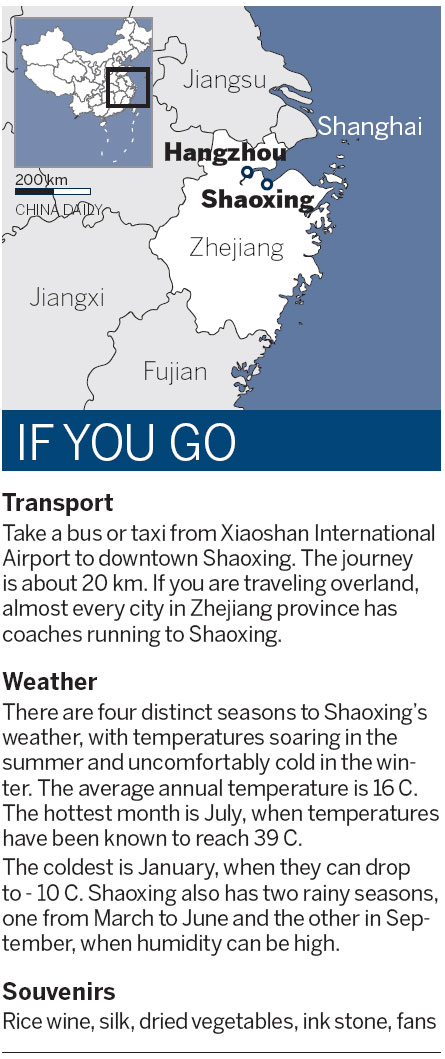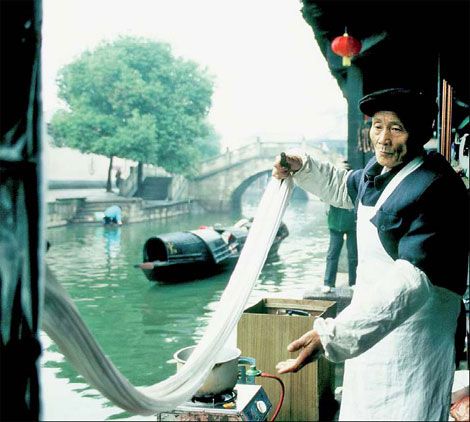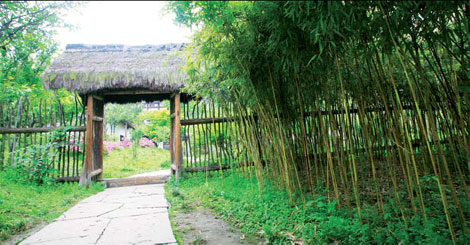From the beginning
Updated: 2013-02-08 07:54
(China Daily)
|
||||||||
|
Taking a Wupeng boat, a unique aquatic vehicle with black cover, is an interesting experience in the watery city. Photos provided to China Daily |
|
Shen's Garden was the setting for a Romeo andJuliet-like story involving a poet and his cousin. Photos provided to China Daily |
Birthplace of revolutionaries, artists and poets, Shaoxing has played an important role in China's history throughout the centuries
The history of Shaoxing stretches back 5,000 years to the earliest settlements of China. Sitting on the southern banks of the Qiantang River, it was once home to the Neolithic Hemudu Culture.
Hemudu people lived by hunting and farming. Their staple food was rice, but they also ate acorns, gourds, monkeys, deer, rhinoceroes, and elephants among other things, according to archaeological finds in the area.
The city has since played an important role in Chinese history. During the Warring States Period (475-221 BC), when seven battling clans fought for dominance, Shaoxing was the capital of the state of Yue. Later, in the Song Dynasty (AD 420-479), it was the main economic, political and cultural center of southern China.
Yu the Great, one of China's legendary rulers in Xia Dynasty (c.21st century-16th century BC) came to Shaoxing twice and succeeded in taming the flood.
Wang Xizhi, a well-known Jin Dynasty calligrapher, was born in Shaoxing, as were Lu You, a Song Dynasty poet, Qiu Jin, a 19th Century female revolutionary, Zhou Enlai, China's first premier and the modern-day author Xu Lun.
The city is lined with canals, crossed by more than 3,000 bridges and is sometimes referred to as the 'town of bridges'. Every bridge has a name connected with a story about a historical figure.
It is also widely known for its wine, meigan cai (a type of dried pickle), and stinky tofu.
And it is home to its own style of Chinese opera sung in the local dialect.
Here is a selection of Shaoxing's top attractions:
1. Shen's Garden
Preserved from the Southern Song Dynasty, Shen's Garden owes its fame to a Romeo and Juliet-like story, involving Lu You and his cousin Tang Wan. Tang's father objected to a relationship between the pair and they were forced by their families to marry others.
Seven years on, when they met again, Lu wrote a poem on the garden wall and Tang responded with her own sorrowful verses, before later dying in a deep depression.
Apart from its sad associations, the garden is also well known for its design. It contains a gourd-shaped pool, a stone bridge and a Song Dynasty well.
2. Former Residence of Cai Yuanpei
Cai Yuanpei, a Chinese educator and the president of Peking University in the early 1900s, was born in Bifei Lane, Shaoxing.
He was known for his critical evaluation of the Chinese culture that led to the influential May Fourth Movement, an anti-imperialist political and cultural movement.
The house consists of three buildings and contains good examples of traditional Shaoxing architecture.
3. Zhou Enlai Museum
Built in the Ming Dynasty, the ancestral home, China's first premier, is on Laodong Road. In 1698, the Qing Dynasty (1644-1911) emperor conferred a title on one of Zhou Enlai's forebears, who had reached a century old, and gave her a sign that read, "Congratulations to you on your 100th birthday." Hence, the building was given the name Hall of a Hundred Years.
In 1939 Zhou Enlai launched a revolutionary movement in Shaoxing that would later see him rise to become one of the Communist Party's main figures.
4. East Lake Scenic Spot
Around three kilometers from downtown Shaoxing, East Lake Scenic Spot combines mountains, stone bridges, pavilions, and of course a lake. Stone from the mountain here has been quarried throughout the centuries and some was used in building the Great Wall.
The area is good for climbing, hiking and viewing a perfect sunset. And for the less energetic visitor there are teas houses and gardens to relax in.
For a tour of the lake take a Wupeng Boat. These long black boats covered with a low roof and decked with straw mats provide a serene and unhurried way of seeing the sights.
China Daily

(China Daily 02/08/2013 page22)

 Li Na on Time cover, makes influential 100 list
Li Na on Time cover, makes influential 100 list
 FBI releases photos of 2 Boston bombings suspects
FBI releases photos of 2 Boston bombings suspects
 World's wackiest hairstyles
World's wackiest hairstyles
 Sandstorms strike Northwest China
Sandstorms strike Northwest China
 Never-seen photos of Madonna on display
Never-seen photos of Madonna on display
 H7N9 outbreak linked to waterfowl migration
H7N9 outbreak linked to waterfowl migration
 Dozens feared dead in Texas plant blast
Dozens feared dead in Texas plant blast
 Venezuelan court rules out manual votes counting
Venezuelan court rules out manual votes counting
Most Viewed
Editor's Picks

|

|

|

|

|

|
Today's Top News
Boston bombing suspect reported cornered on boat
7.0-magnitude quake hits Sichuan
Cross-talk artist helps to spread the word
'Green' awareness levels drop in Beijing
Palace Museum spruces up
First couple on Time's list of most influential
H7N9 flu transmission studied
Trading channels 'need to broaden'
US Weekly

|

|









